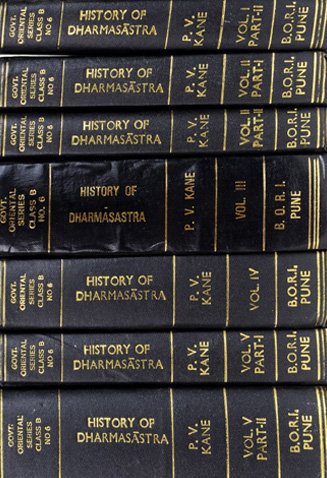Ashtakapala, Aṣṭākapāla, Aṣṭakapāla, Ashtan-kapala: 7 definitions
Introduction:
Ashtakapala means something in Hinduism, Sanskrit. If you want to know the exact meaning, history, etymology or English translation of this term then check out the descriptions on this page. Add your comment or reference to a book if you want to contribute to this summary article.
The Sanskrit terms Aṣṭākapāla and Aṣṭakapāla can be transliterated into English as Astakapala or Ashtakapala, using the IAST transliteration scheme (?).
In Hinduism
Dharmashastra (religious law)
Source: Sacred Texts: The Grihya Sutras, Part 2 (SBE30)Aṣṭākapāla (अष्टाकपाल) is the name of an oblation, as mentioned in the Āpastamba-yajña-paribhāṣā-sūtras.—“the Aṣṭā-kapāla for Agni, the Ekādaśa-kapāla for Agnī-Ṣomau, and the Upāṃśuyāga (the muttered offering of butter), form the principal acts at the Paurṇamāsī, the full moon. The other Homas are Aṅga. The Aṣṭā-kapāla for Agni, the Ekādaśa-kapāla or Dvādaśa-kapāla for Indra-Agnī, form the principal acts at the Amāvāsyā, the new moon, in the case of one who does not sacrifice with Soma”.
The Aṣṭākapāla is the cake baked in eight cups, the Ekādaśakapāla that baked in eleven cups, and respectively destined for Agni and Soma. What is meant are the sacrificial acts for which these cakes are used.

Dharmashastra (धर्मशास्त्र, dharmaśāstra) contains the instructions (shastra) regarding religious conduct of livelihood (dharma), ceremonies, jurisprudence (study of law) and more. It is categorized as smriti, an important and authoritative selection of books dealing with the Hindu lifestyle.
Shaktism (Shakta philosophy)
Source: Google Books: ManthanabhairavatantramAṣṭakapālat (अष्टकपालत्) refers to the “protector of the eight”, according to the Śrīmatottara-tantra, an expansion of the Kubjikāmatatantra: the earliest popular and most authoritative Tantra of the Kubjikā cult.—Accordingly, “[...] In the middle he should think of (the goddess) who is oozing nectar in all directions. He whose body has been satisfied by eating (that nectar) becomes the cosmic man (viraja). When he has practiced this mental Yoga (sufficiently) and meditated on (this) perfectly full maṇḍala called Aghora, who is not successful? He himself becomes (Svacchandabhairava) the Protector of the Eight (aṣṭakapāla) who pervades all the principles of existence. He himself becomes of the nature of the Moon and should be contemplated in the calyx (of the lotus of the Heart)”.

Shakta (शाक्त, śākta) or Shaktism (śāktism) represents a tradition of Hinduism where the Goddess (Devi) is revered and worshipped. Shakta literature includes a range of scriptures, including various Agamas and Tantras, although its roots may be traced back to the Vedas.
Languages of India and abroad
Sanskrit dictionary
Source: DDSA: The practical Sanskrit-English dictionaryAṣṭakapāla (अष्टकपाल).—a. (°ṣṭā°) prepared or offered in 'eight' pans.
-laḥ a sacrifice in which ghee is offered in eight pans.
Aṣṭakapāla is a Sanskrit compound consisting of the terms aṣṭan and kapāla (कपाल).
Source: Cologne Digital Sanskrit Dictionaries: Shabda-Sagara Sanskrit-English DictionaryAṣṭākapāla (अष्टाकपाल).—mfn.
(-laḥ-lī-laṃ) Prepared in eight pans. m.
(-laḥ) 1. A sacrifice in which ghee, is offered in eight vessels. E. aṣṭa and kapāla the convexity of a jar.
Source: Cologne Digital Sanskrit Dictionaries: Monier-Williams Sanskrit-English Dictionary1) Aṣṭakapāla (अष्टकपाल):—[=aṣṭa-kapāla] [from aṣṭa > aṣṭan] mfn. = aṣṭā-kap q.v., [Pāṇini 6-3, 46] [commentator or commentary]
2) Aṣṭākapāla (अष्टाकपाल):—[=aṣṭā-kapāla] [from aṣṭā > aṣṭan] (aṣṭā-) mfn. (an oblation) prepared or offered in eight pans, [Vājasaneyi-saṃhitā; Aitareya-brāhmaṇa; Śatapatha-brāhmaṇa]
Source: Cologne Digital Sanskrit Dictionaries: Yates Sanskrit-English DictionaryAṣṭākapāla (अष्टाकपाल):—(laḥ) 1. m. A sacrifice in which eight vessels are used.
[Sanskrit to German]
Sanskrit, also spelled संस्कृतम् (saṃskṛtam), is an ancient language of India commonly seen as the grandmother of the Indo-European language family (even English!). Closely allied with Prakrit and Pali, Sanskrit is more exhaustive in both grammar and terms and has the most extensive collection of literature in the world, greatly surpassing its sister-languages Greek and Latin.
See also (Relevant definitions)
Partial matches: Ashta, Kapala.
Starts with: Ashtakapalam.
Full-text: Ekadashakapala, Dvadashakapala, Ashtakapalam, Kapalashtaka, Vasuman.
Relevant text
Search found 6 books and stories containing Ashtakapala, Aṣṭā-kapāla, Aṣṭān-kapāla, Astan-kapala, Astakapala, Aṣṭan-kapāla, Aṣṭākapāla, Aṣṭakapāla, Ashtan-kapala, Asta-kapala, Ashta-kapala, Aṣṭa-kapāla; (plurals include: Ashtakapalas, kapālas, kapalas, Astakapalas, Aṣṭākapālas, Aṣṭakapālas). You can also click to the full overview containing English textual excerpts. Below are direct links for the most relevant articles:
Apastamba Yajna-paribhasa-sutras (by Hermann Oldenberg)
Mahabharata (English) (by Kisari Mohan Ganguli)
Section CCXX < [Markandeya-Samasya Parva]
The Sacrifices of Rajasuya, Vajapeya and Ashvamedha (study) (by Aparna Dhar)
Summary of the Punarādheya Sacrifice < [Chapter 2 - Vedic Sacrifices described in the Śatapatha Brāhmaṇa]
Details of the Rājasūya Sacrifice < [Chapter 4 - Major Sacrifices of the Śatapatha Brāhmaṇa]
Vedic influence on the Sun-worship in the Puranas (by Goswami Mitali)
Part 12 - Savitṛ (the Bestower of Wisdom and Intelligence) < [Chapter 2 - Salient Traits of the Solar Divinities in the Veda]
Mimamsa interpretation of Vedic Injunctions (Vidhi) (by Shreebas Debnath)
Soma in Vedic Mythology and Ritual (study) (by Anjana Chakraborty)